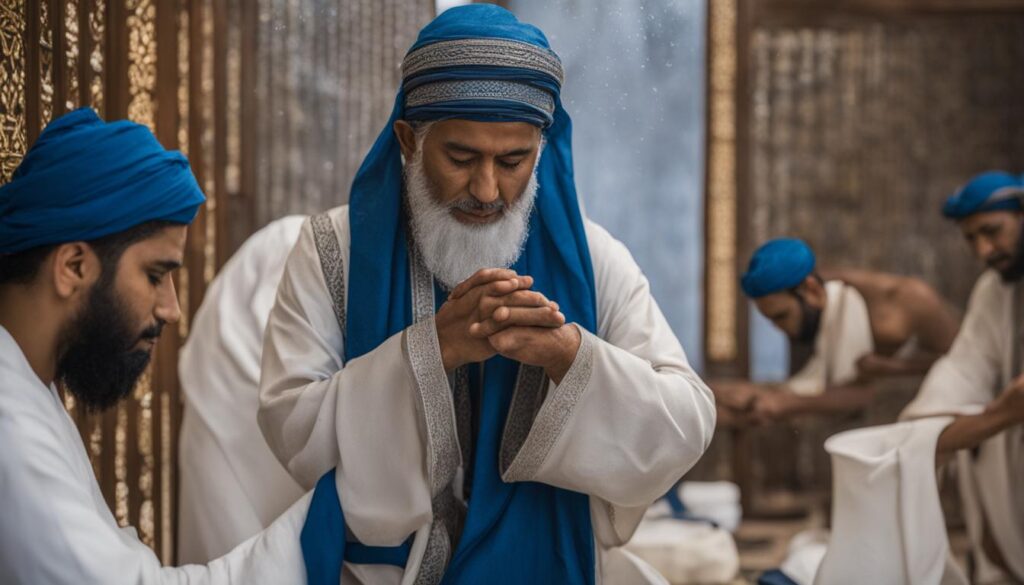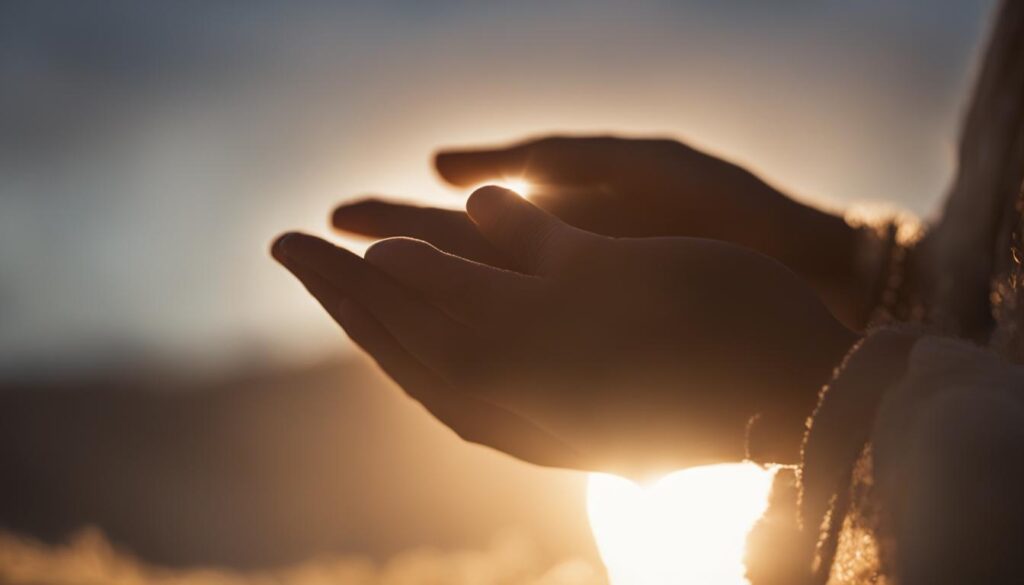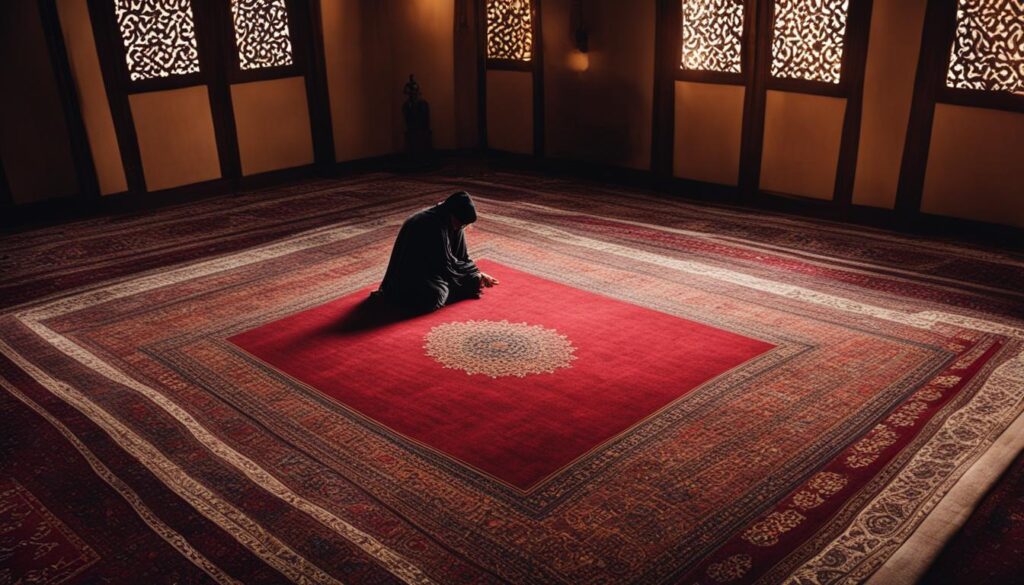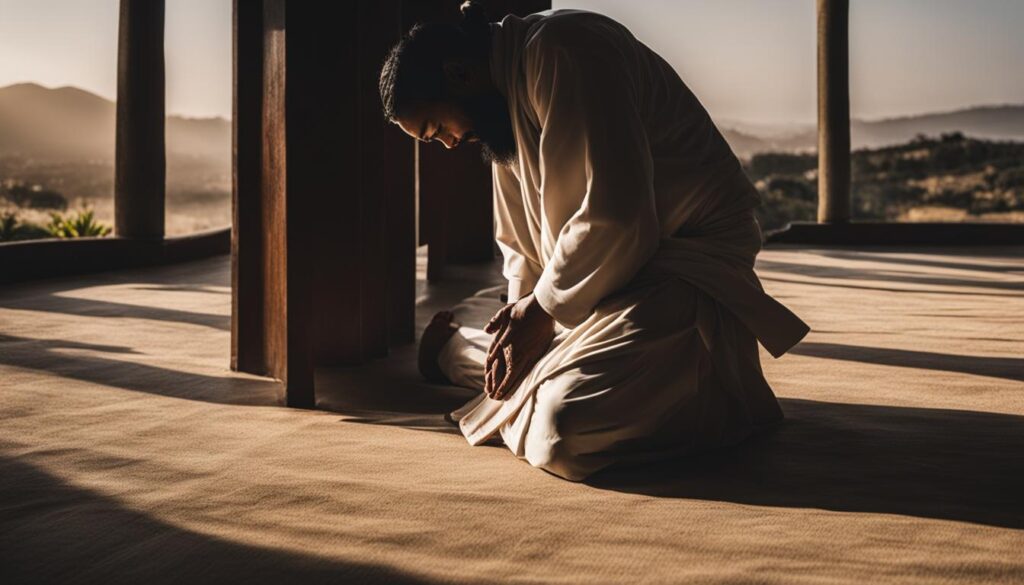The Isha prayer is the fifth and final obligatory prayer of the day. It is a four-rakat prayer, consisting of both sunnah (optional but recommended) and fard (obligatory) prayers. In this comprehensive guide, we will take you through the step-by-step process of performing the Isha prayer, including the necessary preparations, recitations, and postures.
Key Takeaways
- Performing the Isha prayer is an important part of a Muslim’s daily routine.
- Isha prayer consists of four rakats, with both sunnah and fard prayers.
- Before starting the prayer, it is necessary to perform wudu.
- Recitation of Surah Al-Fatiha and additional verses is required during the prayer.
- Postures such as ruku and sujood are performed during the Isha prayer.
Preparing for the Isha Prayer: Performing Wudu
Before starting the Isha prayer, it is important to perform wudu, or ablution. This sacred act involves purifying oneself by washing specific parts of the body with clean water. Wudu is an essential prerequisite for engaging in prayer, as it symbolizes the physical and spiritual cleansing of one’s self before standing in the presence of Allah.
Steps for Performing Wudu:
- Begin by saying “Bismillah” (In the name of Allah) to seek His blessings and protection.
- Wash both hands up to the wrists, beginning with the right hand and then the left, ensuring that water reaches every part.
- Rinse the mouth three times, using your right hand to cup the water and cleansing your mouth and throat.
- Inhale water into the nostrils and then blow it out three times.
- Wash the face three times, from the hairline to the chin and from ear to ear, ensuring that the water reaches all areas.
- Wash the right forearm, starting from the fingertips and moving up to the elbow, three times. Repeat for the left forearm.
- Wipe the head, using a moistened hand to pass over the entire head once.
- Wash the feet, starting with the right foot and moving up to the ankles, making sure to clean between the toes. Repeat for the left foot, using three washes for each foot.
Performing wudu not only physically cleanses the body but also serves as a spiritual preparation for prayer. It allows the worshipper to enter a state of purity and focus, ready to connect with Allah through the act of prayer.

Table: Key Steps of Wudu
| Steps for Wudu | Description |
|---|---|
| 1 | Say “Bismillah” (In the name of Allah). |
| 2 | Wash both hands up to the wrists. |
| 3 | Rinse the mouth three times. |
| 4 | Inhale water into the nostrils and blow it out three times. |
| 5 | Wash the face three times. |
| 6 | Wash the right forearm three times. |
| 7 | Wipe the head once. |
| 8 | Wash the feet three times. |
Setting Your Intention for the Isha Prayer
Before starting the Isha prayer, it is crucial to set your intention (niyyah) in your heart and mind. The intention serves as a reminder of your purpose and dedication to worship Allah with sincerity and devotion. By consciously focusing on your intention, you ensure that your prayers are performed for the sake of Allah alone, seeking His blessings and seeking nearness to Him.
Setting your intention for the Isha prayer involves reflecting on the significance of this act of worship and aligning your thoughts and actions accordingly. It is a moment of introspection where you reaffirm your commitment to fulfilling your religious obligations and seeking spiritual growth.
As you prepare to engage in the Isha prayer, take a few moments to center yourself and focus your mind on the purpose behind your actions. By consciously setting your intention, you infuse your prayers with meaning and elevate them from mere ritualistic motions to a genuine connection with the Divine.

The Power of Intention
Intention plays a crucial role in the spiritual journey of a Muslim. It is through the purity and sincerity of intention that our actions are elevated and transformed into acts of worship. The Prophet Muhammad (peace be upon him) emphasized the significance of intention, stating that “Verily, actions are judged by intentions.”
Therefore, as you embark on the Isha prayer, let your intention guide your every movement and recitation. Remind yourself of the countless blessings and rewards that await those who perform their prayers with sincerity. Embrace the opportunity to seek closeness to Allah and strengthen your relationship with Him through this act of worship.
Remember, the intention is not a mere formality but a powerful tool that can transform your prayers into a source of spiritual nourishment and fulfillment. By setting your intention for the Isha prayer, you embark on a journey of self-reflection, devotion, and obedience to Allah’s command.
Table
| Benefits of Setting Intention for the Isha Prayer |
|---|
| 1. Connects you with the purpose of worship |
| 2. Enhances the sincerity and devotion in your prayers |
| 3. Elevates your prayers to a deeper spiritual level |
| 4. Strengthens your relationship with Allah |
| 5. Fosters mindfulness and presence during prayer |
Beginning the Isha Prayer: Takbir and Standing
Starting the Isha prayer is an important moment as you transition into a state of focus and devotion. It begins with the takbir, where you proclaim “Allahu Akbar” meaning “Allah is the Greatest.” This powerful declaration sets the tone for the prayer and serves as a reminder of the greatness of Allah.
After saying the takbir, you stand facing the Qiblah, the direction of the Kaaba in Mecca. This sacred direction represents the unity and oneness of Muslims worldwide. Standing with a straight back and folded hands, you prepare yourself for the next steps of the Isha prayer.
The act of standing in the Isha prayer signifies your readiness to engage in worship and connect with Allah. It is a physical manifestation of your spiritual commitment and dedication. As you stand, you leave behind the distractions of the world and turn your attention solely towards Allah.
The Importance of Standing in the Isha Prayer
“And stand before Allah, devoutly obedient” – Surah Al-Baqarah (2:238)
Standing in the Isha prayer is not only a physical posture but also a symbol of humility and surrender to Allah’s will. It is a reminder that we are in the presence of the Almighty and submit ourselves to His guidance and mercy. By standing in prayer, we acknowledge our dependence on Allah and seek His blessings and guidance in our lives.
Throughout the Isha prayer, the act of standing serves as a constant reminder of our connection to Allah and the importance of remaining steadfast in our faith. It is a time to reflect, seek forgiveness, and express gratitude for the blessings in our lives. Standing in the Isha prayer allows us to fully immerse ourselves in the worship and experience the spiritual tranquility that comes with it.

| Key Points | Takbir | Standing |
|---|---|---|
| Description | Proclaim “Allahu Akbar” to mark the beginning of the prayer. | Stand facing the Qiblah, the direction of the Kaaba, with a straight back and folded hands. |
| Significance | Reminds us of the greatness of Allah and our readiness for worship. | Serves as a symbol of humility, surrender, and connection to Allah. |
| Importance | Highlights the oneness of Allah and our submission to His will. | Allows us to fully engage in worship and experience spiritual tranquility. |
Reciting Surah Al-Fatiha and Additional Verses
Recitation is an integral part of the Isha prayer, allowing Muslims to connect with Allah and seek His guidance and blessings. In the Isha prayer, the recitation of Surah Al-Fatiha is obligatory in the first and second rakats. Surah Al-Fatiha, also known as “The Opening,” is a chapter from the Quran that holds immense significance and is recited in every unit of the prayer.
In addition to Surah Al-Fatiha, Muslims have the option to recite additional verses or chapters from the Quran in each rakat of the Isha prayer. One popular choice is Surah Al-Ikhlas, a concise yet profound chapter that emphasizes the oneness of Allah. Its recitation in the Isha prayer reinforces the belief in the unity and uniqueness of Allah.
“Say, He is Allah, [who is] One. Allah, the Eternal Refuge. He neither begets nor is born, nor is there to Him any equivalent.” – Surah Al-Ikhlas (112:1-4)
While reciting these verses, Muslims are encouraged to focus on the meanings and reflect on the message conveyed by the words of Allah. This spiritual connection through recitation enhances the overall experience of the Isha prayer, deepening one’s devotion and sense of awe in the presence of Allah.

Performing Ruku and Sujood in the Isha Prayer
The Isha prayer incorporates specific postures that help believers establish a deeper connection with Allah. These postures include ruku (bowing) and sujood (prostration), which are performed during the prayer. These physical acts of devotion demonstrate humility and submission to Allah, allowing individuals to express their gratitude and seek His blessings.
During ruku, the worshipper bows down, placing their hands on their knees while praising and glorifying Allah. This posture symbolizes surrender and acknowledgement of Allah’s greatness. It also serves as a reminder of the significance of humbling oneself before the Creator.
In sujood, the worshipper prostrates with their forehead, hands, and knees touching the ground. This position signifies complete submission to Allah’s will and seeks His mercy and forgiveness. It is a moment of intense connection, as the worshipper humbly beseeches Allah for guidance and blessings.

Benefits of Ruku and Sujood
The acts of ruku and sujood in the Isha prayer hold numerous spiritual and physical benefits. By bowing down and prostrating, individuals increase their focus and concentration, allowing them to disconnect from worldly distractions and connect with Allah on a deeper level. These postures also help in promoting flexibility and blood circulation, contributing to physical well-being.
Moreover, ruku and sujood are acts of obedience and display of devotion to Allah. They serve as a means of seeking forgiveness for one’s shortcomings and sins, while also demonstrating gratitude for Allah’s blessings. The humility exhibited during these postures strengthens the individual’s relationship with Allah and reinforces their commitment to the principles of Islam.
| Ruku | Sujood |
|---|---|
| Hands on knees | Forehead, hands, and knees on the ground |
| Reciting praise and glorification of Allah | Supplicating and seeking Allah’s forgiveness |
| Symbolizes surrender and acknowledgement of Allah’s greatness | Signifies complete submission and seeking mercy |
The table provides a visual summary of the key aspects of ruku and sujood in the Isha prayer. It highlights the different physical postures, the actions performed, and the symbolic meaning behind each posture.
By incorporating ruku and sujood into the Isha prayer, Muslims are reminded of their humble place in the universe and the importance of seeking Allah’s guidance and mercy. These acts of physical devotion deepen the spiritual experience and allow individuals to foster a stronger connection with their Creator.
Repeating the Rakats in the Isha Prayer
After completing the first two rakats of the Isha prayer, it is time to repeat the same actions and recitations to complete the remaining two rakats. This repetition ensures the fulfillment of the Isha prayer and strengthens the connection with Allah. Let’s take a look at the step-by-step process of repeating the rakats in the Isha prayer:
Repeating the Actions
1. After completing the second rakat, return to the standing position by saying “Allahu Akbar.”
2. Begin the third rakat by reciting Surah Al-Fatiha followed by an additional portion of the Quran, such as Surah Al-Ikhlas.
3. Perform the ruku and sujood as you did in the previous rakats, displaying reverence and submission to Allah.
Repeating the Recitations
1. Recite Surah Al-Fatiha in the third rakat, just as you did in the first and second rakats.
2. Add an additional portion of the Quran, such as Surah Al-Ikhlas, in the third rakat.
3. In the fourth and final rakat, recite Surah Al-Fatiha and another portion of the Quran.
By repeating the rakats in the Isha prayer, we establish a consistent pattern of devotion and seek Allah’s blessings. It is a time to reflect, seek forgiveness, and strengthen our spiritual connection. The repetition serves as a reminder of the importance of consistency and commitment in our worship.
Performing the Final Tashahhud and Taslim
After completing the four rakats of the Isha prayer, it is time to enter the final phase of the prayer. This phase includes the tashahhud and taslim, which are important elements of concluding the prayer with humility and gratitude.
To begin, you should sit in a position of reflection and supplication known as the final tashahhud. In this position, you can recite specific prayers that express your devotion to Allah and seek His forgiveness. It is a moment to offer blessings upon the Prophet Muhammad and seek His intercession on your behalf. Take this time to engage in personal supplications and express gratitude for the opportunity to perform the Isha prayer.
Following the final tashahhud, the prayer concludes with the taslim, a simple yet profound gesture of peace. You should turn your head to the right and say, “Assalamu alaikum wa rahmatullah” (Peace be upon you and the mercy of Allah), and then turn your head to the left and repeat the same greeting. The taslim signifies the completion of the Isha prayer and serves as a reminder of the importance of peace and unity in our daily lives.
Benefits of Performing the Final Tashahhud and Taslim
The final tashahhud and taslim carry great significance and hold numerous benefits. By engaging in reflection and supplication during the tashahhud, you have the opportunity to seek forgiveness, express gratitude, and ask for blessings. This moment of personal connection with Allah strengthens your bond and deepens your faith.
The taslim, on the other hand, serves as a reminder of the importance of peace and unity in Islam. It is a gesture of goodwill towards fellow believers and a symbol of harmony within the Muslim community. By offering the greeting of peace to both sides, you reaffirm your commitment to fostering love, respect, and understanding among fellow worshippers.
In conclusion, the final tashahhud and taslim are important aspects of the Isha prayer. They provide an opportunity for personal reflection, supplication, and the expression of peace and unity. Through these actions, you can enhance your spiritual connection with Allah and cultivate a sense of gratitude, forgiveness, and harmony in your daily life.
Benefits and Rewards of Praying Isha
The Isha prayer holds immense benefits and rewards for those who perform it with sincerity and devotion. By engaging in this final obligatory prayer of the day, Muslims can experience spiritual upliftment, seek forgiveness, and attain closeness to Allah. Here are some of the key benefits and rewards of praying Isha:
1. Spiritual Purification:
Praying Isha offers a unique opportunity to purify the soul and seek repentance. It allows individuals to reflect on their actions throughout the day and seek forgiveness from Allah. Engaging in this prayer regularly can lead to a heightened sense of self-awareness and a stronger commitment to righteousness.
2. Connection with Allah:
Praying Isha enables Muslims to establish a deep and personal connection with Allah. By devoting time to worshiping Him, individuals can strengthen their bond with the Creator and experience a sense of solace and peace. This connection helps in finding guidance and drawing closer to Allah’s infinite mercy and blessings.
3. Completion of Daily Obligation:
Performing the Isha prayer fulfills the final obligatory act of worship for the day. By fulfilling this duty, adherents of Islam demonstrate their commitment to their faith and their willingness to submit to the will of Allah. It brings a sense of accomplishment and satisfaction, knowing that all the obligatory acts of worship for the day have been completed.
4. Balance in Spiritual Life:
Praying Isha contributes to a balanced and fulfilling spiritual life. By observing this essential prayer, individuals can maintain a consistent connection with Allah throughout the day and find solace and guidance in times of difficulties. It helps in grounding oneself and finding peace amidst the challenges of daily life.
Overall, the Isha prayer carries immense benefits and rewards for those who engage in it with devotion and sincerity. It allows individuals to experience spiritual purification, seek closeness to Allah, fulfill their daily obligation, and find balance in their spiritual lives. By incorporating this prayer into their daily routine, Muslims can reap the countless blessings and rewards associated with it.
Conclusion
The Isha prayer is an important aspect of a Muslim’s daily spiritual practice. By following the step-by-step process outlined in this guide, you can learn how to pray Isha with confidence and deepen your connection with Allah. The Isha prayer guide provided here offers a comprehensive overview of the necessary preparations, recitations, and postures involved in performing the Isha prayer.
Praying Isha holds numerous benefits and rewards. It allows you to seek closeness to Allah, attain spiritual purification, and seek His forgiveness. By incorporating the Isha prayer into your daily routine, you can experience a balanced and fulfilling spiritual life. Remember to set your intention for each prayer and approach it with sincerity and devotion.
We hope that this guide has equipped you with the knowledge and understanding of how to pray Isha. As you embark on your journey of prayer, may your prayers be accepted and bring you peace and tranquility. Continue to learn and grow in your relationship with Allah, for prayer is a beautiful and powerful way to connect with the Divine.
FAQ
What is the Isha prayer?
The Isha prayer is the fifth and final obligatory prayer of the day for Muslims.
How many rakats are there in the Isha prayer?
The Isha prayer consists of four rakats.
What is wudu?
Wudu is the process of ablution, which involves washing the hands, arms, face, and feet with clean water before starting the prayer.
What is niyyah?
Niyyah is the intention that one sets in the heart and mind before starting the prayer, focusing on seeking nearness to Allah and performing the prayer with sincerity and devotion.
How do you start the Isha prayer?
To start the Isha prayer, say the takbir (“Allahu Akbar”) and stand facing the Qiblah, the direction of the Kaaba in Mecca.
What do you recite during the Isha prayer?
The recitation of Surah Al-Fatiha is required in the first and second rakats of the Isha prayer. Additionally, you may choose to recite a portion of the Quran, such as Surah Al-Ikhlas, in each rakat.
What are the postures in the Isha prayer?
The postures in the Isha prayer include ruku (bowing) and sujood (prostration).
How do you repeat the rakats in the Isha prayer?
After completing the first two rakats, you repeat the same actions and recitations to complete the remaining two rakats.
What do you do after completing the four rakats of the Isha prayer?
After completing the four rakats of the Isha prayer, you sit in the final tashahhud and recite specific prayers, including blessings upon the Prophet Muhammad and seeking forgiveness from Allah. The prayer concludes with the taslim, a greeting of peace to the right and left.
What are the benefits of praying Isha?
Praying Isha offers benefits such as seeking closeness to Allah, attaining spiritual purification, and seeking His forgiveness.
How can I deepen my connection with Allah through the Isha prayer?
By following the step-by-step process outlined in this guide, you can confidently perform the Isha prayer and deepen your connection with Allah.








